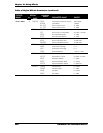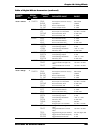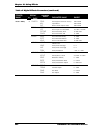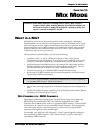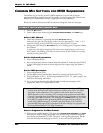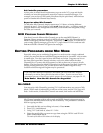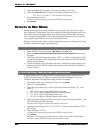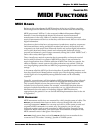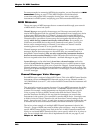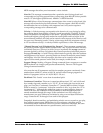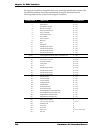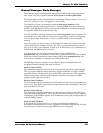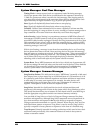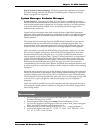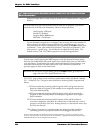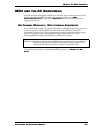
Chapter 12: MIDI Functions
248 ANDROMEDA A6 REFERENCE MANUAL
For some examples in connecting MIDI devices together, see our illustrations in MIDI
Connections
starting on page 23. This MIDI Chapter will take these basic
connections and provide many examples of using your A6 to control other
instruments in a MIDI system, and playing your A6 from another MIDI device.
MIDI MESSAGES
The are two types of MIDI messages that are communicated through your network
of MIDI cables: Channel and System.
Channel Messages are typically the messages you’ll be most concerned with for
routine MIDI operations and can originate (be transmitted) from virtually any device
in the system. MIDI provides 16 “Channels” through which certain MIDI data is
shared among devices in the system. The communication of certain messages along
Channels makes it possible to connect many devices together but allows you to
specify which devices communicate directly with each other. For example, you
could have seven MIDI devices that are all connected to each other. Two of the
devices can be communicating on Channel 2, two others on Channel 9 and the
remaining three on Channel 4, as one possible setup.
Channel messages are further divided into two groups: Voice messages and Mode
messages. Because these messages are channelized (they are communicated on a
designated Channel number), they are only recognized by instruments that have
been set to receive on that Channel (or Omni On mode which tells the receiving
device to respond to data from all Channels – see Mode Messages on page 251).
System Messages, on the other hand, do not have a channel number and can be
received by any device in a system. This permits devices in a MIDI system to share
certain data without having to be set to a particular Channel. System messages, like
Channel messages, can originate from just about any MIDI device in the system. The
three types of System messages are called Real Time messages, Common messages and
Exclusive messages.
Channel Messages: Voice Messages
Each MIDI device is assigned a Basic MIDI Channel. This is the MIDI Channel that the
instrument will use to transmit MIDI data and can be set to any Channel number 1 -
16. If OMNI Mode is set to
OFF, this is also the MIDI Channel that the instrument will
receive on.
This principle is not set in concrete, however. For many MIDI instruments, the ability
to communicate – both transmit and receive – on several Channels at once is quite
common. For example, certain instruments are designed such that you can set a
Voice or group of voices to MIDI Channels other than the Basic Channel. This
provides enormous flexibility in the way that the instrument can control other
instruments in the system, or be controlled by another MIDI device. You might want
to think of a device’s Basic Channel as the one that other Channel settings can be
based – hence the word “basic”. A good place to start is a setup that instructs the unit
to transmit and receive on the Basic Channel, then build from there if you need to.
The A6 is a prime example of a multiple MIDI Channel instrument in that its Mix
Channels – ranges of MIDI notes used to define splits and layers – may be assigned a
specific MIDI Channel to play from. Each of the A6’s 16 Mix Channels transmit and
receive on a selected MIDI Channel and allow you to specify which of its 16 voices to
play. For an in-depth look at how this is implemented on the A6, see page 47, and
Chapter 11: Mix Mode.



